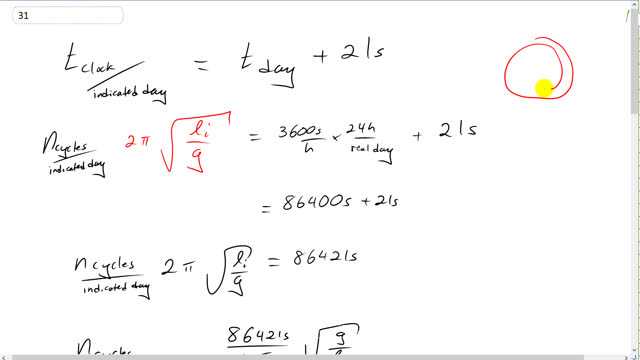
Your grandfather clock’s pendulum has a length of 0.9930 m. If the clock runs slow and loses 21 s per day, how should you adjust the length of the pendulum?

In order to watch this solution you need to have a subscription.
This is Giancoli Answers with Mr. Dychko. A grandfather clock requires a certain number of cycles to advance the minute hand around the entire clock face twice, you know, because each swing of the pendulum advances the minute hand a certain number of degrees and that happens, you know, so many times with every tick and tock of the clock. And so the question we have to answer is how many full pendulum swings advance the minute hand around the... I should be saying the hour hand the hour hand around the entire clock face twice in other words which how many cycles of the pendulum advanced the clock through 24 hours, through 24 indicated hours I should say. So, I hope that made some sense. So, we're solving for first is the number of times of the pendulum clock swings back and forth in order to move the hour hand from 12 or around to 12 again and then around to 12 again. And I'm not I'm being careful not to say 24 hours because who knows how long it'll take for this hour hand to go around the clock face twice the clock is not accurate. So, and it turns out that it's 21 seconds off. So, it doesn't take 24 hours for the hour hand to go around the clock face twice because the clock is miscalibrated. Now... But regardless of how fast the clock is advancing the hour hand, the number of cycles for the pendulum to move this hour hand around the clock face entirely around it twice is going to remain the same. OK. So... Let's proceed. So, we have the amount of, number of seconds it takes for the clock to indicate a day, and this is not a real 24 hour day, this is a indicated day by the clock, in other words the amount of time it takes for the hour hand to go around to complete circles is the amount of time in a real day plus 21 seconds. Because this clock is 21 seconds slow, it takes an additional 21 seconds in addition to the number of seconds in a real day to indicate that a day has passed. And so this is the number of cycles to indicate a day times by the period of the clock 2π times the square root of its length initial divided by g. This is initial length because we're gonna be changing the length of the pendulum in a minute. And that equals 3600 seconds per hour times 24 hours per day plus an additional 21 seconds. And so that's a 86,421 seconds. It takes this long for the clock to indicate a day has passed. And we're gonna be solving for the number of cycles. Multiply both sides by square root g and divide both sides by 2π square root l initial. And you get this line here. And so n, the number of cycles to indicate a day, is 86,421 seconds divided by 2π times square root 9.8 meters per second squared divided by 0.9930 meters. And that's 43,209.3599 cycles per indicated day. So, no matter what the pendulum length is, when the pendulum undergoes this many cycles, the clock face will declare that a day has passed. So, that's how many cycles it takes for the hour hand to go from the 12 and around of the 12 once and then around of the 12 a second time take this number of cycles to indicate a day has passed. OK. Now, what we want is for this many cycles multiplied by some period to equal a genuine 86,400 seconds in a day. So, we'll solve for the pendulum length required to make that happen. So, divide by 2π times number of cycles, both sides. And I'm not writing the cycles per indicated day here anymore even though it's the same n, just because to save some writing. And so, and then square both sides and then after squaring, multiply both sides by g. And then you get that the proper length for this pendulum in order to be accurate and calibrated is 86,400 seconds divided by 2π n squared times g. So, that's 86,400 seconds divided by 2π times this number of cycles to move that hour hand twice around the clock face, 43209.3599, square that, times 9.8. And that length will be 0.9925175 meters. So, that's different from the initial length that we had by 0.9925175 meters minus 0.9930 meters. And this difference is precise to this place value here, the ten thousandths place I guess. And so we round it to there, and that's negative 0.5 millimeters. So, we should, the negative sign means shorten it. So, the length should be shortened by 0.5 millimeters in order to have all these have all these... What is it? 43,209 cycles to pass during a genuine day of 86,400 seconds.
How do i solve it if I need to treat g as an unknown? I am asked to do the same excersize, but to treat the constant g as unknown (that is, do not assume it is equal to exactly 9.80 m/s^2)